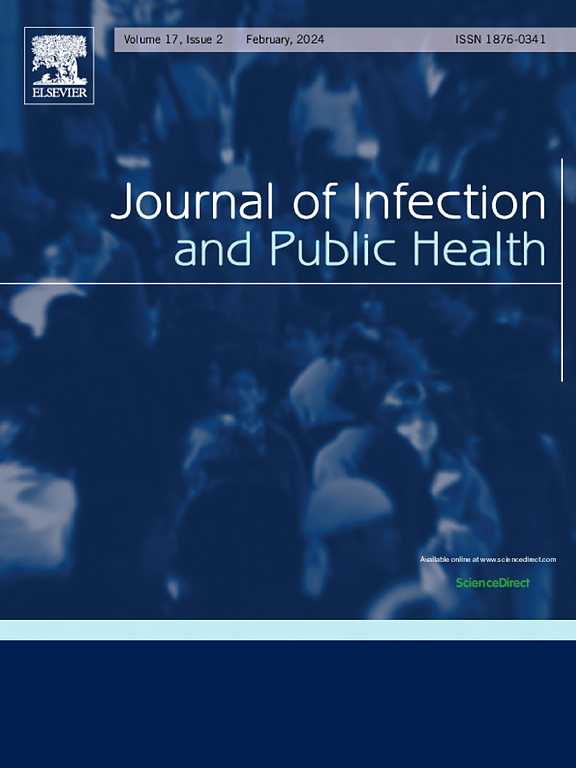Resilience and emergence of pneumococcal serotypes and lineages in adults post-PCV13 in Spain: A multicentre study
IF 4.7
3区 医学
Q1 INFECTIOUS DISEASES
引用次数: 0
Abstract
Background
Streptococcus pneumoniae causes invasive pneumococcal disease (IPD) in adults. The introduction of pneumococcal conjugate vaccines (PCVs) has reduced vaccine serotypes but has also led to the rise of non-vaccine serotypes. The aim of this study was to analyse pneumococcal lineages and their association with recent changes in IPD among adults in Spain.
Methods
Data from adult IPD cases (≥18 years) were collected from six Spanish hospitals in 2019–2021. Strains were serotyped, tested for antibiotic susceptibility and subjected to whole genome sequencing (WGS). Findings were compared with data from previous periods (2008–2016).
Results
A total of 655 IPD episodes were examined. Pneumonia was the main focus (515/655), and 366 episodes occurred in adults over 64 years. Although IPD incidence decreased during COVID-19 pandemic, the burden of disease caused by PCV13 serotypes was significant. Notably, serotype 3 persisted (GPSC12-ST180 and GPSC83-ST260), and a new serotype 4 lineage emerged (GPSC162-ST13022). Among non-PCV13 serotypes, serotype 8 expanded (GPSC3-ST53) and a new serotype 12F lineage emerged (GPSC55-ST8060). Most serotypes presented a dominant Global Pneumococcal Sequencing Cluster (GPSC) like GPSC16-ST67 of 9N or GPSC19-ST433 of 22F. Nevertheless, some GPSCs were associated with several serotypes, the most numerous were GPSC3 (serotypes 8, 11A, and 33F) and GPSC6 (serotypes 11A and 14). The overall penicillin non-susceptibility rate was 17.0 %, 14.6 % resistance for meningitis and 1.6 % for pneumonia (15.1 % susceptible at increased exposure [SIE]). Serotypes 11A and 14 (GPSC6-ST156/6521) and 19A (GPSC1-ST320) had penicillin MICs above 1 mg/L. Acquired resistance genes associated with macrolide and/or tetracycline resistance were present in 19.4 % of isolates, particularly among serotypes 6C (GPSC47-ST386/4310) and 19A (GPSC1-ST320).
Conclusions
The burden of PCV13 serotypes in adult IPD remains significant, and serotype 3 is the primary contributor. However, the rise of stable lineages associated with non-PCV13 serotypes, particularly 8, 9N, and 22F highlights a shifting epidemiology. The persistence of multidrug-resistant lineages, such as GPSC6-ST156 and GPSC1-ST320, emphasizes the need for continued surveillance. Vaccination of high-risk adults with current and broader coverage PCVs would help to control the burden of pneumonia and IPD among adults.
西班牙成人pcv13后肺炎球菌血清型和谱系的恢复力和出现:一项多中心研究
背景:肺炎链球菌引起成人侵袭性肺炎球菌病(IPD)。肺炎球菌结合疫苗(PCVs)的引入减少了疫苗血清型,但也导致非疫苗血清型的增加。本研究的目的是分析西班牙成人肺炎球菌谱系及其与IPD近期变化的关系。方法:收集2019-2021年西班牙6家医院成人IPD病例(≥18岁)的数据。对菌株进行血清分型、抗生素敏感性检测和全基因组测序。研究结果与之前时期(2008-2016年)的数据进行了比较。结果:共检查了655例IPD发作。肺炎是主要焦点(515/655),在64岁以上的成年人中发生了366次发作。虽然IPD发病率在COVID-19大流行期间有所下降,但PCV13血清型引起的疾病负担仍显着。值得注意的是,血清3型持续存在(GPSC12-ST180和GPSC83-ST260),新的血清4型谱系出现(GPSC162-ST13022)。在非pcv13血清型中,血清8型扩大(GPSC3-ST53),新的血清12型 F谱系出现(GPSC55-ST8060)。大多数血清型呈现显性全球肺炎球菌测序集群(GPSC),如GPSC16-ST67的9 N或GPSC19-ST433的22 F。然而,一些GPSCs与几种血清型相关,最多的是GPSC3(血清型8、11 A和33 F)和GPSC6(血清型11 A和14)。总的青霉素不敏感率为17.0 %,脑膜炎耐药率为14.6 %,肺炎耐药率为1.6 %(暴露量增加时敏感率为15.1 % [SIE])。血清型11 A、14 (GPSC6-ST156/6521)和19 A (GPSC1-ST320)的青霉素mic均在1 mg/L以上。19.4% %的分离株存在与大环内酯和/或四环素耐药相关的获得性耐药基因,特别是在血清型6 C (GPSC47-ST386/4310)和19 A (GPSC1-ST320)中。结论:PCV13血清型在成人IPD中的负担仍然显著,其中血清3型是主要因素。然而,与非pcv13血清型相关的稳定谱系的增加,特别是8,9 N和22 F,突出了流行病学的变化。GPSC6-ST156和GPSC1-ST320等多药耐药谱系的持续存在,强调了继续监测的必要性。对目前和更广泛覆盖的pcv高危成人进行疫苗接种将有助于控制成人肺炎和IPD的负担。
本文章由计算机程序翻译,如有差异,请以英文原文为准。
求助全文
约1分钟内获得全文
求助全文
来源期刊

Journal of Infection and Public Health
PUBLIC, ENVIRONMENTAL & OCCUPATIONAL HEALTH -INFECTIOUS DISEASES
CiteScore
13.10
自引率
1.50%
发文量
203
审稿时长
96 days
期刊介绍:
The Journal of Infection and Public Health, first official journal of the Saudi Arabian Ministry of National Guard Health Affairs, King Saud Bin Abdulaziz University for Health Sciences and the Saudi Association for Public Health, aims to be the foremost scientific, peer-reviewed journal encompassing infection prevention and control, microbiology, infectious diseases, public health and the application of healthcare epidemiology to the evaluation of health outcomes. The point of view of the journal is that infection and public health are closely intertwined and that advances in one area will have positive consequences on the other.
The journal will be useful to all health professionals who are partners in the management of patients with communicable diseases, keeping them up to date. The journal is proud to have an international and diverse editorial board that will assist and facilitate the publication of articles that reflect a global view on infection control and public health, as well as emphasizing our focus on supporting the needs of public health practitioners.
It is our aim to improve healthcare by reducing risk of infection and related adverse outcomes by critical review, selection, and dissemination of new and relevant information in the field of infection control, public health and infectious diseases in all healthcare settings and the community.
 求助内容:
求助内容: 应助结果提醒方式:
应助结果提醒方式:


